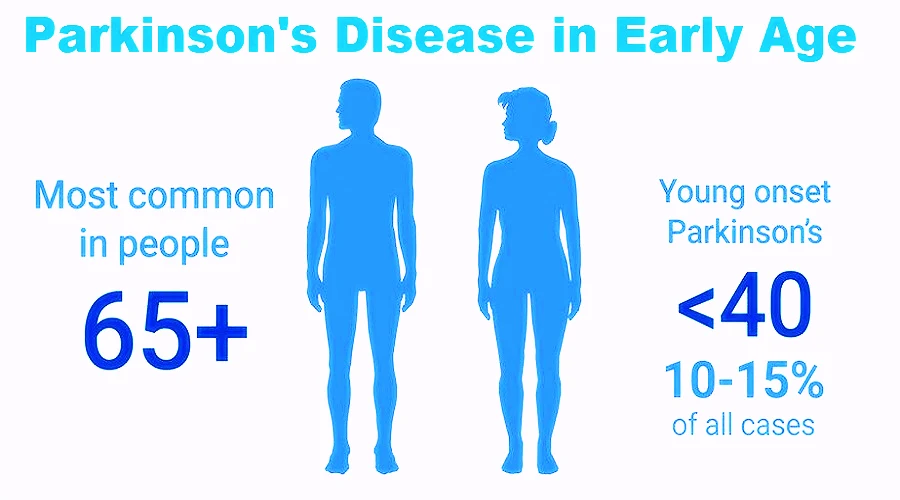Parkinson's disease generally begins in middle or late life, and the risk increases with age. It is uncommon to see Parkinson's disease in people under the age of 50. Some people may have symptoms of Parkinson's disease before the age of 50, which is called "Young Onset Parkinson's disease (YOPD)".
Symptoms of Parkinson's Disease: Can Young Adults Get Parkinson's Disease?
Parkinson's Disease
Parkinson's disease is a progressive nervous system disorder that occurs mostly among middle-aged and elderly people over 60 years old.
April 11 2021 was the 25th World Parkinson's Disease Day. The theme of Parkinson’s Day this year was "Comprehensive Treatment, Quality of Life".
According to public data, more than 10 million people worldwide are living with Parkinson's disease, approximately 60,000 Americans are diagnosed with PD each year, in China, the prevalence of Parkinson's disease among elderly people over 65 is 1.7%, which means that the number of Parkinson's patients in China exceeds 3 million. Although Parkinson's disease is not uncommon, our knowledge of it can be said to be pitiful. Except for the tremor of hands, few people can tell more about Parkinson's disease.
In recent years, patients with Parkinson's disease have shown a younger trend, most of whom have long-term exposure to toxic and harmful substances or have a family genetic history.
Young-Onset Parkinson's Disease (YOPD)
People with Parkinson's disease are diagnosed with an average age of 60. It is uncommon to see Parkinson's disease in people under the age of 50, but for a small subset of those affected, the disease spreads early.
About 10 to 20% of people with Parkinson's disease have symptoms before the age of 50, which is called "Young Onset Parkinson's disease (YOPD)".
YOPD affects about 4% of the one million people with PD in the United States.
Younger people may experience the disease differently but the treatments are the same.
Scientists are working to understand the reasons behind the emergence of Parkinson's disease at an early age.
What is the youngest age for Parkinson's disease?
The youngest recorded case of Parkinson's disease was a 12-year-old patient.
Parkinson's disease is considered young-onset if diagnosed before the age of 40.
The term '"Young Onset Parkinson's disease (YOPD)" is used to describe the emergence and development of Parkinson's disease symptoms in individuals between the ages of 21 and 40 years.
Symptoms of Parkinson's Disease
The symptoms of Parkinson's Disease include involuntary shaking of the hands, head, or mouth when stationary, muscle stiffness, slow movement, and postural balance disorders, which lead to inability to take care of themselves.
Shaking hands is the initial manifestation of Parkinson's disease, but Parkinson's disease is far more than just shaking hands.
The initial symptoms of Parkinson's disease are often tremors or shaking from one side of the hand, and then gradually progress to the lower limbs, head, and even other parts of the body.
As the disease progresses, clinical manifestations such as muscle stiffness, difficulty starting, slow movement, and abnormal gait will gradually appear.
The later stages of the disease are often accompanied by depression, dementia, and dysphagia, which cause great pain to the patient.
What are the other symptoms of Parkinson's besides shaking hands?
When it comes to Parkinson's disease, people think of shaking hands, but shaking hands does not mean Parkinson's.
Symptoms of hand tremors in Parkinson's disease are different. They usually start from one upper or lower limb. In addition to hand tremors, they are also accompanied by other symptoms, such as slow movements, stiffness, and tremor.
In addition to shaking hands, leg pain and depression may also be early signs of Parkinson's disease.
Other symptoms of Parkinson's disease besides shaking hands include:
Bradykinesia (Slowness of Movement)
Bradykinesia is one of the cardinal symptoms of Parkinson's disease. Sluggishness is an early symptom of Parkinson's disease. Its main manifestations are difficulty in buttoning up, difficulty in tying shoelaces or wearing socks, easy to fall when picking vegetables, small handwriting, and difficulty to read handwriting.
Rigidity (Stiffness)
Stiff legs or arms and feet, it is difficult to reach into the sleeves when wearing clothes, and it is difficult to reach into the shoes when wearing shoes.
Loss of smell
More than half of patients can experience loss of smell at an early stage, which can be diagnosed by olfactory examination and imaging examination.
Conclusion:
Parkinson's disease itself is not life-threatening, nor does it affect life expectancy. However, if you have not been treated for a long time, your physical fitness can be reduced, making life unable to take care of yourself, and the disability rate is relatively high.
Medicine can be used to control the condition in the early stage, and surgical treatment is necessary when needed.

